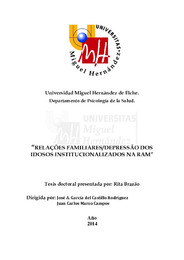Por favor, use este identificador para citar o enlazar este ítem:
https://hdl.handle.net/11000/1653Registro completo de metadatos
| Campo DC | Valor | Lengua/Idioma |
|---|---|---|
| dc.contributor.advisor | Marzo Campos, Juan Carlos | - |
| dc.contributor.author | Vale Brazão, Rita Maria | - |
| dc.contributor.other | Departamentos de la UMH::Psicología de la Salud | es |
| dc.date.accessioned | 2014-07-28T10:28:15Z | - |
| dc.date.available | 2014-07-28T10:28:15Z | - |
| dc.date.created | 2014-06-30 | - |
| dc.date.issued | 2014-07-28 | - |
| dc.identifier.ismn | 359 | - |
| dc.identifier.uri | http://hdl.handle.net/11000/1653 | - |
| dc.description.abstract | It was estimated the predominance of depression and its relationship with the factor risks already known in a sample of 180 elderly people staying at Care Homes, all of them with more than 50 years old, distributed in 2 groups. These groups are: Group I (elderly accompanied by the family), Group II (elderly not accompanied by the family), for that it was used a geriatric depression scale (Yesavage et al., 1983), to identify whether they had depression or not. One has concluded that there was a high depression rate (63,3%), of which 74,4% were women, whereas men manifested only a 25,6% rate of depression. One could also verify that the distribution of the elderly by categories such as marital status is not identical, 30% of the elderly accompanied by the family are married, whilst within the elderly who are not accompanied by the family, prevail those who are widowers (55,6%) and those who are single (28,9%), fact which brings to what was expected, the elderly who are not accompanied by the family present a depression rate of 63,3%, much higher than the group of the elderly accompanied by the family (36,7%). To confirm ones expectations, 64,9% of the elderly with no depression are accompanied by the family. Fact that caused some surprise was the variable “number of children “in which the depression diagnosis is independent of the number of children (value-p=0,434), the elderly depression percentage is similar for the 2 groups no matter the number of children that are considered, the differences observed are not statistically significant.Due to that it is suggested a wide-ranging case-study, to better understand the relationship between the depression by lack of familiar accompanying and the high rate of depression in institutionalized elderly people. Key-words: Elderly people, depression, institutionalization, familiar accompanying, risk factors. | es |
| dc.format | application/pdf | es |
| dc.format.extent | 284 | es |
| dc.language.iso | spa | es |
| dc.rights | info:eu-repo/semantics/openAccess | es |
| dc.subject | familia | es |
| dc.subject | depresión | es |
| dc.subject | envejecimiento | es |
| dc.subject.other | CDU::1 - Filosofía y psicología::159.9 - Psicología | es |
| dc.title | Relaçoes familiares/Depressão dos idosos institucionalizados na ram | es |
| dc.type | info:eu-repo/semantics/doctoralThesis | es |

Ver/Abrir:
Tesis Vale Brazao, R..pdf
6,01 MB
Adobe PDF
Compartir:
.png)
